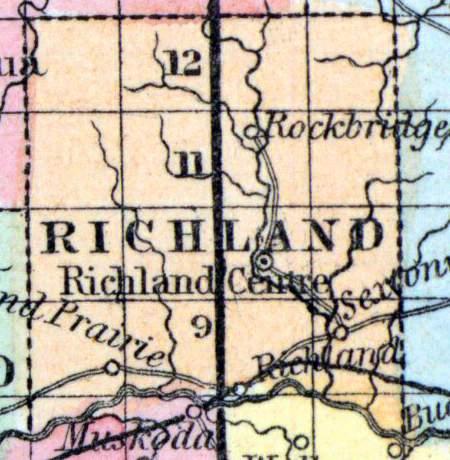RICHLAND COUNTY, situated in the westerly part of Wisconsin, with Wisconsin river on the south. Area, -------- square miles. Seat of justice, Richmond. Pop. in 1850, 903. (Fanning's, 1853)
RICHLAND, County, is bounded on the north by Bad Ax and Sauk, on the east by Sauk, on the south by Iowa, and on the west by Bad Ax and Crawford, and is about 24 miles square. It contains 16 townships in a square form, and some fractional ones on the Wisconsin river, which constitutes its southern boundary. It was set off from Iowa county 15th Feb. 1842, remaining attached thereto for judicial purposes until Feb. 7, 1850. The seat of justice has been established at Richland Centre. The county is connected with the second congressional district, the fifth judicial circuit, and the fifteenth senate district, and constitutes an assembly district. It is divided into five towns, as follows:—Buena Vista on the east side, comprising towns 9, 10, 11, 12 N., of range 2 E., and one tier of sections from the east side of town 9 N., of range 1 E.—Richland, town 10 N., of range 1 E.—Rockbridge, town 12 N. of range
1 E., and 11 and 12 N. of range 1 W.—Richwood, town 9, 10, 11, and 12 N. of range 2 W., and 2 tiers of sections from the west side of towns 9 and 10, of range 1 W.—Richmond, 4 eastern tiers of sections from towns 9 and 10, of range 1 W., and 5 tiers of sections from the western part of town 9 N., of range 1 E. There are 4 considerable mill streams running from north to south through the county, emptying into the Wisconsin—Bear Creek, in the east part—Pine River, running through the central—Eagle Creek, more westerly—and Knapp's Creek, in the extreme west. These streams, with their tributaries, supply the county abundantly. The water is invariably soft. There are some pretty prairies surrounded by groves of heavy timber. The face of the country is diversified by hills and valleys. Fishes—pike, pickeral, codfish, mullet, suckers, and speckled trout are in abundance. Plenty of the best timber such as maple, butternut, walnut, bass, ash, elm and oak of different kinds, with pine and poplar. Lead and copper have been discovered in the southern part. A marble quarry has been opened in the valley of the Bear Creek. All the stone is found in quarries—none scattered on the surface. There are many large tracts of well-watered and rich land in the county—hence the name. The county is settling rapidly with an intelligent and enterprizing population, almost wholly Americans. Its agricultural, mineral and lumbering resources, together with its proximity to an extensive mining country, and its facilities for market, serve as great inducements to settlement and cultivation. There are many thriving villages. Perhaps there is no greater natural curiosity in the West than the natural bridge of the Pine river, located on the middle of the northwest quarter of section 10, town 11 N., of range 1. It is a rock from 40 to 60 feet high, and over 1-1/2 miles long, and extends into a level country, with a beautiful arch, sufficiently large for the waters of the Pine river in times of flood. The rock is solid for 30 feet above the water, and is covered with a beautiful grove of thrifty pines. It is a species of sand stone, four rods wide and perpendicular (except where it projects over) its entire length. This forms a great water power, and also shelter for man and beast. The Indians used to assemble here in great numbers to worship, the chief or principal speaker standing upon the top of the rock whilst his audience remained below. Another curiosity is a warm cave, which sends forth a warm current of air at all seasons. Population in 1850 was 903, now about 3,000; with 76 farms, 175 dwellings, and 4 manufactories. (John Warren Hunt, Wisconsin Gazetteer..., Madison, 1853)

